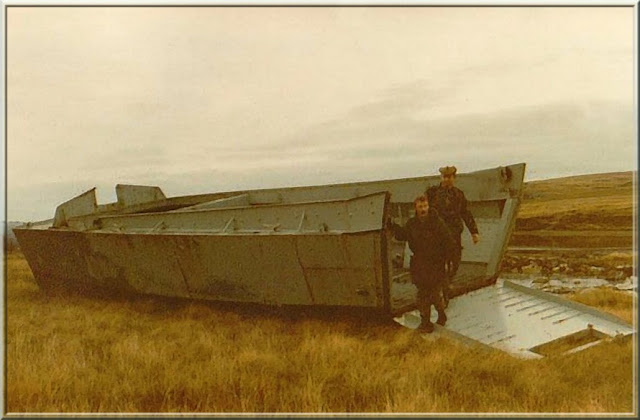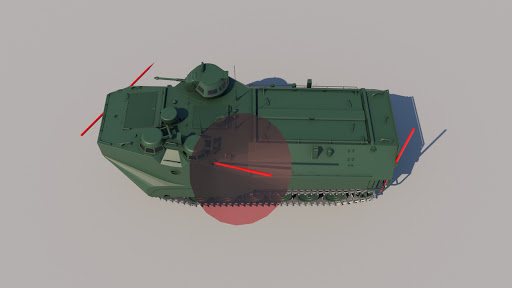►5 Reasons why The First Casualty (Falklands War book) by Ricky D. Phillips is wrong⛔️
The 5 major faults with The First Casualty by Ricky D. Phillips, a book about the Argentine landing in the Falklands on April 2nd, 1982
Click on pictures to enlarge
There's 5 capital flaws in The First Casualty theory about dozens of hidden Argentine casualties:
- There's no sign of battle damage on the LCVP supposedly sunk on April 2nd, 1982.
- There's pictures showing that same LCVP captured by British forces, in good condition, moored in Stanley.
- The hole in the commander's cuppola of the Amtrac supposedly hit by the Royal Marines, is actually the mounting point of a removed auxiliary viewport.
- The Amtrac's rear light cluster shown as proof of impact, is a falsified piece made of a different material.
- The damage in the Amtrac's nose section doesn't match with an impact of HEAT ammunition. The Amtrac internal layout makes impossible to affect the crew with an impact in that point.
1. The LCVP is not damaged.
2. The LCVP was captured intact by the British forces in June 14th, 1982.
A Post Wat Picture of the LCVP
A previously unseen picture of the LCVP surfaced in this Facebook group
(picture is the 38th of that large collection) called 'Falklands
History, The Facts', showing two British soldiers posing next to it. It
is undoubtedly our LCVP in question, showing the 'double panel'
distinctive feature discussed in the main article.
[The picture disappeared from the collection, coincidentally,
Ricky D. Phillips is one of the administrators of that group]
The distinctive beret of the second soldier is a Tam o' Shanter, used only by a limited number of Scottish regiments. One of those regiments were the Queen's Own Highlanders who arrived on July 1st, 1982. They were too late to participate in combat, so they ended up relieving the troops that fought on Operation Corporate. I asked in several Facebook QO HLDR groups, and one of the Sergeants of D Company helped me to obtain precise information:
"[We arrived on]1 Jul to 20 Jul 82. We were sent to take West Falkland but the garrison there surrendered before we got there so we ended up being the 'clean up' garrison who reburied the dead (both sides) and cleared as much of the debris of war that we could until Dec 82, when we were relieved by the Royal Hampshire Regiment [1 R HAMPS].
Soldier at rear of photo is nicknamed 'Geordie' and the front soldier is called Sammy. Location confirmed as East Beach by Stanley Airport. i.e. if you look at Whalebone Cove then go NORTH there is a very wide beach (called Yorke Bay) which is where Sammy recalls there being the LCVP and a destroyed Panhard armoured vehicle. Locals in the Falklands have confirmed it and the vehicle are no longer there but unsure when they were removed/scrapped. This is all we can recall - sorry. [Picture was taken in] Mid July, 1982."
From this picture and the information kindly provided, we can conclude that:
The double panel is present and the lack of ID number match with the one pictured in The First Casualty. If its LCVP #9 with the ID number erased, or a third landing craft previously unaccounted for, it's subject to further investigation.
It clearly shows that
there's no damage or reparation signs on its side, and that 'welded and
soldered patch' claimed by Phillips is just a structural feature of the
boat.
UPDATE FEB 23:
I found another picture of the LCVP in the Facebook Group called "Comando Xma Brigada" (picture number 30 of the 'Moody Brook' album), uploaded in May 2012. The boat is clearly more weathered, suggesting it was photographed a few years after the war. The wider shot also permits to situate the LCVP in the vicinity of Moody Brook, as some islanders like Taff Davies and Gavin Short have commented in reaction to my posts in Facebook Groups.
I asked my contact in the QO HLDR about the discrepancy with his account:
Despite the location issue, the conclusions still stand: there's no sign of impact, the craft is the same pictured in The First Casualty, and the 'patch' is an integral structural feature."The Jocks said they were certain it was York Bay but that could be Moody Brooke in the background left side.. after 40 years all our memories are going I think. Could it have been moved for target practice or to tidy up the barracks area?"
3. The LVTP-7 VAO 17 wasn't hit in the cuppola.
The next picture is from an M-113 APC hit by HEAT RPGs, and it’s relevant because it’s made with an aluminum alloy similar to the LVTP-7, and is 38 mm thick in the sides, while the Amtrac sides are 35 mm. As it can be seen, apart from the obvious penetration holes, the superficial damage is considerable, something similar should be present in VAO 17:
Definitely, there's no indication of battle damage behind the cuppola.
4. The rear light cluster shown as proof is false.
Here's some more detailed pics of the piece:
The main problem with this relic is simple: while it seems to be made of rusty steel, the real shroud is made of aluminium, like the rest of the vehicle.
5. The damage in the nose section doesn't match with an impact of HEAT ammunition.
Instead of an exit hole in the side, there's an entry hole. It certainly looks like a penetration, but the lack of spalling/pitting damage in the surroundings, no burnt or melted surface in the hole itself and the bent aluminum sheet suggest a low velocity blunt force impact with another rigid object, maybe another vehicle or the Cabo San Antonio’s ramp when reembarking from the water. The bulkhead right behind it also looks undamaged, so whatever happened, it didn’t compromise the crew section either.
Here's pictures of a real LVTP-7 with the rear ramp open, showing the crew compartment and engine section:
In this report, "Marine Corps Assault Amphibious Vehicle Survivability Upgrade" of the Inspector General U.S. Department of Defense, (Report No. DODIG-2018-060, Page 18), we can confirm the internal disposition of the vehicle, showing the troop compartment, power pack section, and the flotation cavity in the nose:
It's rational to conclude that such an impact would have resulted in a mobility kill at best. In fact, the real cause of the nose patches is an impact with the Tank Landing Ship's frontal ramp doors during a practice in 1987. A more detailed analysis is available in this article.
Conclusions:
To sum it up, we have an LCVP without any battle damage, captured intact by British forces, an APC with a hole behind the cuppola that's there by design, a falsified rear light, and damage in its nose that not only doesn't match with Phillips' account, but it also wouldn't affect the crew inside it, even if it was effectively hit by enemy fire.
In fact, VAO 17 was the only vehicle that wasn't in service when the Landing occured, despite Phillips' misquoting Argentine books "admitting" that it went to the Falklands.
I'm still working in other aspects of the supposed hidden casualties, however, there's no denying that The First Casualty has serious methodologic and corroboration issues. Nonetheless, reading the personal renditions of the people and soldiers involved in that fateful day is still a very valuable trait.
However, I strongly advise to take the book's conclusions with a grain of salt, just about the size of VAO 17.
















































